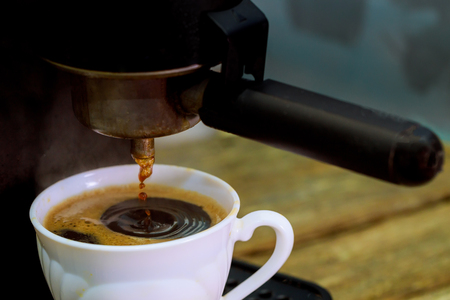1. Understanding Caffeine and Its Role in Coffee
Caffeine is a natural stimulant found in coffee beans, tea leaves, and even cocoa. In the world of coffee, its the ingredient that gives you that familiar energy boost and mental alertness. But what exactly does caffeine do to our bodies, and why are so many Americans choosing decaf?
What Is Caffeine?
Caffeine is a bitter substance that naturally occurs in over 60 plants. Its most commonly consumed through beverages like coffee, tea, soda, and energy drinks. In coffee, caffeine levels can vary depending on the bean type and how it’s brewed. On average, an 8-ounce cup of regular coffee contains about 95 mg of caffeine.
How Does Caffeine Affect the Body?
When you drink a cup of caffeinated coffee, caffeine enters your bloodstream and heads straight for your brain. It blocks a neurotransmitter called adenosine, which helps you feel more awake and alert. This is why many people rely on their morning cup of joe to kickstart the day.
Common Effects of Caffeine
| Effect | Description |
|---|---|
| Increased Alertness | Helps improve focus and concentration |
| Energy Boost | Stimulates the central nervous system |
| Elevated Heart Rate | May cause a faster heartbeat in sensitive individuals |
| Anxiety or Jitters | Too much can lead to nervousness or restlessness |
| Sleep Disruption | Can interfere with falling or staying asleep if consumed late in the day |
Why Do People Choose Decaf?
Despite how popular regular coffee is in the United States—where over 60% of adults drink it daily—many people opt for decaffeinated versions. Some are sensitive to caffeine’s side effects, while others want to enjoy the taste of coffee without the late-night buzz.
Top Reasons Americans Choose Decaf Coffee
- Caffeine Sensitivity: Some people experience jitters or anxiety from even small amounts of caffeine.
- Health Conditions: People with heart issues or acid reflux may be advised to limit caffeine intake.
- Pregnancy: Many pregnant women reduce or avoid caffeine for health reasons.
- Evening Enjoyment: Decaf allows for a relaxing cup after dinner without affecting sleep.
- Taste Preference: Some simply enjoy the flavor of coffee without needing the stimulation.
Caffeine plays a big role in why we love coffee—but it’s not the only reason we drink it. For millions of Americans, decaf offers a way to enjoy their favorite brew without sacrificing comfort or sleep.
2. How Decaffeination Works: The Main Methods
Ever wondered how your favorite cup of decaf coffee loses its caffeine? There are several methods used to remove caffeine from coffee beans, and each one has its own science behind it. Let’s break down the three most common decaffeination processes: the Swiss Water Process, the CO2 Process, and chemical solvent methods like Methylene Chloride or Ethyl Acetate. These techniques aim to strip away the caffeine while trying their best to preserve the flavor we all love.
Swiss Water Process
This method is completely chemical-free and uses only water, temperature, and time. It starts by soaking green (unroasted) coffee beans in hot water to dissolve the caffeine along with other soluble compounds like oils and flavors. Then, this water is passed through a special carbon filter that captures only the caffeine molecules. This creates a solution called “Green Coffee Extract” (GCE). New batches of beans are then soaked in this GCE—since it already contains flavor compounds but no caffeine, only the caffeine from the new beans is extracted. This method is popular among health-conscious consumers and is often labeled as “100% chemical-free.”
Carbon Dioxide (CO2) Process
This method uses pressurized carbon dioxide to remove caffeine. Green coffee beans are placed in a stainless steel chamber and soaked in water. Then, liquid CO2 is added under high pressure. The CO2 binds with the caffeine molecules but leaves behind most of the flavor compounds. Afterward, the CO2-caffeine mixture is transferred to another chamber where the pressure is released, allowing the CO2 to evaporate and leave behind pure caffeine. The CO2 can then be reused in future cycles, making this process eco-friendly and efficient.
Chemical Solvent Methods
This process involves using food-safe chemical solvents like Methylene Chloride or Ethyl Acetate to selectively remove caffeine. The beans are either steamed or soaked in water to open their pores, then rinsed with the solvent which bonds with the caffeine molecules. After extracting the caffeine, the beans are steamed again to remove any traces of solvent before drying. Although this method is highly effective and widely used due to its cost efficiency, some people prefer other methods because of concerns over chemical use—even though FDA regulations ensure safety.
Comparison Table of Decaffeination Methods
| Method | Main Ingredient Used | Chemical-Free? | Flavor Preservation | Common Use |
|---|---|---|---|---|
| Swiss Water Process | Water & Carbon Filter | Yes | High | Specialty & Organic Coffees |
| CO2 Process | Pressurized Carbon Dioxide | Yes | High | Larger Commercial Batches |
| Chemical Solvent Method | Methylene Chloride or Ethyl Acetate | No | Moderate to High | Mainstream Decaf Brands |
A Quick Note on Flavor Impact
No matter which method is used, some loss of flavor is almost unavoidable during decaffeination. However, modern techniques have come a long way in preserving aroma and taste, so you can still enjoy a delicious cup without all the buzz.
![]()
3. The Flavor Factor: What Gets Lost (or Gained)?
When caffeine is removed from coffee, it’s not just the buzz that goes away—flavor and aroma can take a hit too. That’s because decaffeination isn’t a simple process of plucking out caffeine molecules. It involves soaking or steaming the beans and using solvents, water, or carbon dioxide to extract the caffeine. These steps can also impact the compounds responsible for flavor and fragrance.
How Decaf Processing Affects Flavor
Different decaffeination methods affect taste in different ways. For example, traditional solvent-based methods may strip away some of the oils that contribute to coffees rich aroma, while water-based processes might mute its acidity or brightness.
Flavor Impact by Decaf Method
| Decaf Method | Flavor Notes | Aroma Retention |
|---|---|---|
| Solvent-Based (Methylene Chloride/Ethyl Acetate) | Milder taste, sometimes flat | Moderate |
| Swiss Water Process | Smooth and clean, less acidic | High |
| CO₂ Process | Closer to regular coffee flavor | Very High |
The American Shift Toward Better Decaf
In the past, decaf had a bad rap in the U.S.—often considered weak or dull in comparison to regular brews. But today, American coffee drinkers have higher expectations. With the rise of specialty coffee culture and increased health awareness, theres been a growing demand for decaf that actually tastes good.
Why U.S. Consumers Are Embracing Quality Decaf:
- Health-Conscious Choices: More people are cutting back on caffeine without giving up coffee altogether.
- Improved Methods: Advances in decaffeination preserve more of the beans original character.
- Specialty Roasters: Many craft coffee roasters now offer high-quality decaf with complex flavor profiles.
The result? Americans no longer have to choose between flavor and going caffeine-free. Today’s decaf options are bolder, richer, and far more satisfying than their old-school counterparts.
4. Is Decaf Really Caffeine-Free?
Many people choose decaf coffee thinking it has zero caffeine, but the truth is a bit more nuanced. While decaf coffee goes through a process to remove most of the caffeine, its not completely caffeine-free.
How Much Caffeine Is Left in Decaf Coffee?
On average, an 8-ounce (about 240 ml) cup of decaf coffee contains roughly 2 to 5 milligrams of caffeine. That’s significantly less than regular coffee, which can have anywhere from 70 to 140 milligrams per cup depending on the roast and brewing method.
Caffeine Comparison Chart
| Beverage | Serving Size | Average Caffeine Content (mg) |
|---|---|---|
| Regular Brewed Coffee | 8 oz | 95 mg |
| Decaf Coffee | 8 oz | 2–5 mg |
| Espresso (single shot) | 1 oz | 63 mg |
| Brewed Black Tea | 8 oz | 40–70 mg |
| Soda (e.g., Coca-Cola) | 12 oz | 30–40 mg |
| Energy Drink (e.g., Red Bull) | 8.4 oz | 80 mg |
Why There’s Still Caffeine in Decaf
The decaffeination process—whether it’s done using water, solvents, or carbon dioxide—removes most but not all of the caffeine. The FDA allows coffee to be labeled “decaf” if it’s at least 97% caffeine-free. That means a small amount of caffeine can still remain in your cup.
Should You Be Concerned?
If youre sensitive to caffeine or trying to avoid it for health reasons, its good to know that decaf isn’t entirely free of it. However, for most people, the trace amounts found in decaf are unlikely to cause any noticeable effects.
5. Why People Choose Decaf: Health, Lifestyle, and Myths
While regular coffee remains a daily ritual for many Americans, decaf has carved out its own niche among coffee lovers. But why do people choose decaffeinated coffee in the first place? Let’s explore some of the most common reasons—ranging from health concerns to lifestyle choices—and clear up a few myths along the way.
Health Reasons
For some individuals, caffeine can trigger unwanted side effects like anxiety, increased heart rate, or digestive issues. Decaf offers a way to enjoy the flavor of coffee without the physical downsides. It’s also recommended for people with certain medical conditions like acid reflux or hypertension where caffeine may worsen symptoms.
Common Health Motivations for Choosing Decaf
| Health Concern | Why Decaf Helps |
|---|---|
| High Blood Pressure | Avoiding caffeine can reduce the risk of elevated blood pressure levels. |
| Anxiety Disorders | Caffeine may intensify symptoms; decaf provides a calmer alternative. |
| Acid Reflux (GERD) | Decaf is generally less acidic and easier on the stomach. |
| Pregnancy | Doctors often advise limiting caffeine intake during pregnancy. |
Lifestyle Choices
Many people switch to decaf as part of a broader lifestyle change. Some want to cut back on stimulants, while others simply prefer drinking coffee later in the day without it disrupting their sleep schedule. For older adults or those trying to manage stress, decaf can be a more suitable everyday option.
When Americans Typically Choose Decaf
- Afternoon or Evening: To avoid sleep disruption while still enjoying a warm beverage.
- During Social Events: Allows participation without overloading on caffeine.
- As Part of a Wellness Routine: Fits into low-stimulant or mindfulness-focused lifestyles.
Busting Common Decaf Myths
There are plenty of misconceptions about decaf coffee. Let’s break down a few of the most common ones:
Myth #1: Decaf Has Zero Caffeine
Reality: While decaf contains much less caffeine than regular coffee, it’s not completely caffeine-free. A typical 8 oz cup of decaf contains about 2-5 mg of caffeine compared to 80-100 mg in regular coffee.
Myth #2: Decaf Tastes Bad
Reality: Thanks to improvements in processing methods and better bean selection, today’s decaf coffees can taste just as rich and flavorful as their caffeinated counterparts—especially when brewed fresh or sourced from specialty roasters.
Myth #3: The Decaffeination Process Uses Harmful Chemicals
Reality: While some older methods used chemical solvents, modern techniques like the Swiss Water Process and CO2-based extraction are safe and widely used in the U.S., offering clean and chemical-free options for consumers.
The choice to go decaf isnt just about avoiding caffeine—its about aligning your coffee habits with your personal health goals, lifestyle preferences, and taste expectations. As more Americans become aware of what goes into their cup, decaf continues to gain popularity across all age groups and backgrounds.


